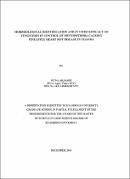| dc.contributor.author | Ocwa, Akasairi, | |
| dc.date.accessioned | 2022-03-25T09:37:38Z | |
| dc.date.available | 2022-03-25T09:37:38Z | |
| dc.date.issued | 2016-12 | |
| dc.identifier.citation | Ocwa, Akasairi(2016) Morphological identification and in vitro efficacy of fungicides in control of phytophthora causing pineapple heart rot disease in Uganda | en_US |
| dc.identifier.uri | https://hdl.handle.net/20.500.12504/945 | |
| dc.description | xiv,65 p.: ill (some col) | en_US |
| dc.description.abstract | Pineapple (Ananas comosus L. Merr) production in Uganda is being constrained by a diversity of
factors including pineapple heart rot disease (PHRD). Information on PHRD causal pathogen is
limited. Also, management options are clear. The objectives of this study were, therefore, to
identify the casual pathogens causing PHRD and assess the in vitro reaction of the causal
pathogens to fungicides. Pathogen isolation was done using amended corn meal agar. Macro and
micro-morphological characteristics of the isolates were assessed. Pathogenicity of the isolates
was tested using healthy pineapple plants based on Koch's postulate. In vitro reaction was
determined using I 0% V8 media amended with 0.1 g/L Metalaxyl, 0.1 g/L Victory 72 powder,
0.01 g/Land 0.001 g/L Metalaxyl, 0.01 g/L and 0.001 g/L Fosetyl Al and unamended V8 media
as a control. There was a significant difference (P<0.05) in the growth rates, hyphae diameter
and asexual structure dimensions of the isolates. Isolates were characterized by a dense rosette
and stoloniferous mycelial growth pattern in PDA media. Sporangia were non-caduceus.
terminal, papillate and mostly ovoid, obpyriform and limoniform sporangia (32-56μm) with a
mean length/breadth ratio of 1.32: I μm . Chlamydospores were spherical and thick-walled (25-
42μm diameter). Sporangiophore branching was sympodial. All the isolates were sensitive to
Metalaxyl and Victory 72 powder treatment. Based on the morphological characteristics of
isolates, it was concluded that Phytophthora nicotianae is the species associated with PHRD in
central Uganda. Additionally, Metalaxyl was the most effective chemical against the pathogen in
vitro. Molecular characterization of the pathogen is recommended to confirm the identity of the
species. It is also recommended that the efficacy of fungicides which have shown effectiveness
be assessed further under field conditions. | en_US |
| dc.language.iso | en | en_US |
| dc.publisher | Kyambogo University (un published work) | en_US |
| dc.subject | Morphological identification. | en_US |
| dc.subject | in vitro efficacy. | en_US |
| dc.subject | Fungicides. | en_US |
| dc.subject | Pineapple heart rot disease. | en_US |
| dc.title | Morphological identification and in vitro efficacy of fungicides in control of phytophthora causing pineapple heart rot disease in Uganda | en_US |
| dc.type | Thesis | en_US |

